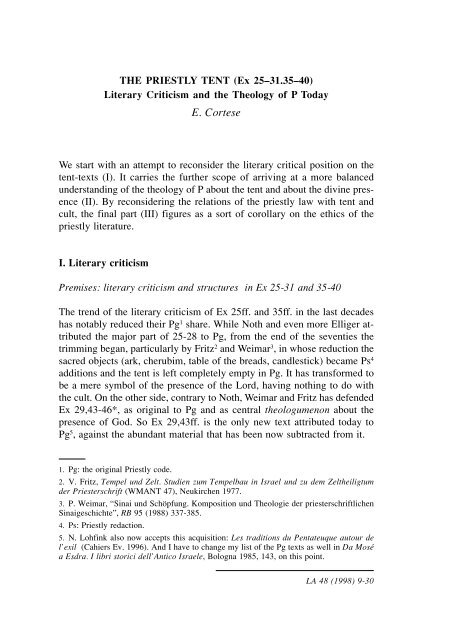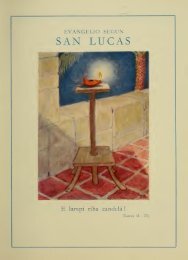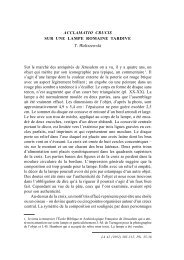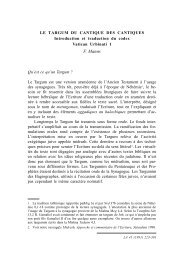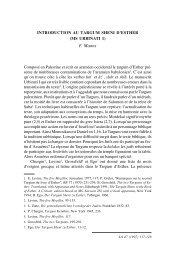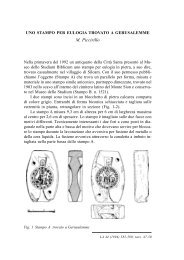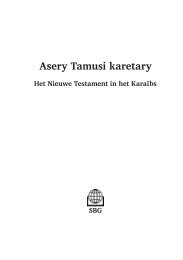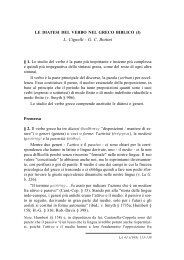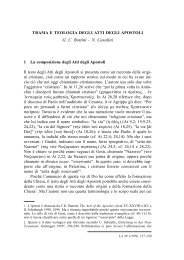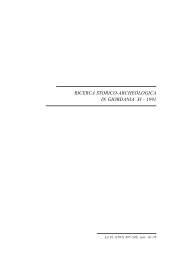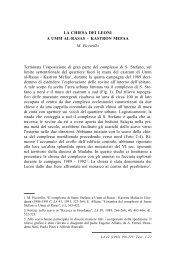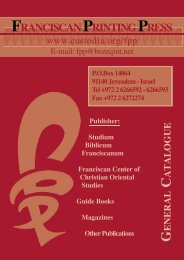Literary Criticism and Theology of P - Christus Rex
Literary Criticism and Theology of P - Christus Rex
Literary Criticism and Theology of P - Christus Rex
Create successful ePaper yourself
Turn your PDF publications into a flip-book with our unique Google optimized e-Paper software.
THE PRIESTLY TENT (Ex 25–31.35–40)<br />
<strong>Literary</strong> <strong>Criticism</strong> <strong>and</strong> the <strong>Theology</strong> <strong>of</strong> P Today<br />
E. Cortese<br />
We start with an attempt to reconsider the literary critical position on the<br />
tent-texts (I). It carries the further scope <strong>of</strong> arriving at a more balanced<br />
underst<strong>and</strong>ing <strong>of</strong> the theology <strong>of</strong> P about the tent <strong>and</strong> about the divine presence<br />
(II). By reconsidering the relations <strong>of</strong> the priestly law with tent <strong>and</strong><br />
cult, the final part (III) figures as a sort <strong>of</strong> corollary on the ethics <strong>of</strong> the<br />
priestly literature.<br />
I. <strong>Literary</strong> criticism<br />
Premises: literary criticism <strong>and</strong> structures in Ex 25-31 <strong>and</strong> 35-40<br />
The trend <strong>of</strong> the literary criticism <strong>of</strong> Ex 25ff. <strong>and</strong> 35ff. in the last decades<br />
has notably reduced their Pg 1 share. While Noth <strong>and</strong> even more Elliger attributed<br />
the major part <strong>of</strong> 25-28 to Pg, from the end <strong>of</strong> the seventies the<br />
trimming began, particularly by Fritz 2 <strong>and</strong> Weimar 3 , in whose reduction the<br />
sacred objects (ark, cherubim, table <strong>of</strong> the breads, c<strong>and</strong>lestick) became Ps 4<br />
additions <strong>and</strong> the tent is left completely empty in Pg. It has transformed to<br />
be a mere symbol <strong>of</strong> the presence <strong>of</strong> the Lord, having nothing to do with<br />
the cult. On the other side, contrary to Noth, Weimar <strong>and</strong> Fritz has defended<br />
Ex 29,43-46*, as original to Pg <strong>and</strong> as central theologumenon about the<br />
presence <strong>of</strong> God. So Ex 29,43ff. is the only new text attributed today to<br />
Pg 5 , against the abundant material that has been now subtracted from it.<br />
1. Pg: the original Priestly code.<br />
2. V. Fritz, Tempel und Zelt. Studien zum Tempelbau in Israel und zu dem Zeltheiligtum<br />
der Priesterschrift (WMANT 47), Neukirchen 1977.<br />
3. P. Weimar, “Sinai und Schöpfung. Komposition und Theologie der priesterschriftlichen<br />
Sinaigeschichte”, RB 95 (1988) 337-385.<br />
4. Ps: Priestly redaction.<br />
5. N. Lohfink also now accepts this acquisition: Les traditions du Pentateuque autour de<br />
l’exil (Cahiers Ev. 1996). And I have to change my list <strong>of</strong> the Pg texts as well in Da Mosé<br />
a Esdra. I libri storici dell’Antico Israele, Bologna 1985, 143, on this point.<br />
LA 48 (1998) 9-30
10<br />
E. CORTESE<br />
This reductionist trend reaches its most radical position in Th. Pola 6 .<br />
He attributes to Pg the usual (<strong>and</strong> classical) portion <strong>of</strong> texts up to Ex 25.<br />
But from Ex 25 onwards his Pg is limited only to 25,1.8a.9; 29,45f. <strong>and</strong><br />
40,16.17a.33b <strong>and</strong> nothing more either in Lev or in Num 7 . The consequences<br />
<strong>of</strong> this reductionist approach to the theology <strong>of</strong> P are obvious.<br />
Such a radicalism invites a more reasonable literary critical approach<br />
towards our texts. At the same time we do not follow here the opposite<br />
trend, which renounces literary criticism, by adopting other exegetical<br />
methods, not to mention fundamentalism.<br />
Now if one gives credit to literary criticism, as we do, one can hardly<br />
accept the proposed structures <strong>of</strong> tent sections <strong>of</strong> P, either in their entirety<br />
or in their parts, if such opinions are proposed without a previous literary<br />
criticism. Such schemes or structures could be proposed only for the end<br />
text, <strong>and</strong> are the product <strong>of</strong> later redaction (Ps) or the result <strong>of</strong> the final<br />
redaction. Therefore many <strong>of</strong> the proposed structures <strong>of</strong> Pg on the Sinai<br />
corpus are to be suspected.<br />
Those structures <strong>of</strong> Pg, which do not presume a prior literary criticism<br />
<strong>and</strong> which are based simply on the supposed parallelism with ANET<br />
accounts <strong>of</strong> temple building <strong>and</strong> on the bipolarism between prescriptive <strong>and</strong><br />
descriptive texts <strong>of</strong> the ancient documents <strong>and</strong> between comm<strong>and</strong> (Ex 25-<br />
31) <strong>and</strong> execution (35-41) 8 , are not acceptable to us. Nor do we agree with<br />
those who build their demonstration <strong>of</strong> the structure purely on literary or<br />
stylistic elements 9 .<br />
There is also a sort <strong>of</strong> structure like the one proposed by Janowski 10<br />
following Weimar, which is based on literary criticism, but presumes that<br />
6. Die ursprüngliche Priesterschrift. Beobachtungen zur Literarkritik und Traditionsgeschichte<br />
von Pg (WMANT 70), Neukirchen 1995.<br />
7. See for instance Pola, Die ursprüngliche Priesterschrift, 343, note 144.<br />
8. B. Levine, “The descriptive Tabernacle texts <strong>of</strong> the Pentateuch”, JAOS 85 (1965) 110-<br />
132. 307-318, has still his followers today.<br />
9. G. Steins, “Sie sollen mir ein Heiligtum machen. Zur Struktur und Entstehung von Ex<br />
24,12 (sic!)-31,18”, in F.L. Hossfeld (Ed.), Vom Sinai zu Horeb. Stationen alt. Glaubensgeschichte,<br />
Würzburg 1989, 145-167. The proposed structure is based principally on the<br />
speech introductions 30,11.17.22.34; 31,1.12, which are irregularly distributed in the<br />
complex. Moreover Steins admits the secondary trait, not only <strong>of</strong> Ex 30f., which the<br />
majority recognizes, but also <strong>of</strong> (28 <strong>and</strong>) 29, which he defends.<br />
10. B. Janowski, “Tempel und Schöpfung. Schöpfungstheologische Aspekte der priesterschr.en<br />
Heiligtum Konzeption”, JBT 5 (1990) 50 (now in Id., Gottesgegenwart in Israel.<br />
Beiträge zur Theologie des AT, Neukirchen 1993, 214-246).
THE PRIESTLY TENT 11<br />
Pg has only the tent <strong>and</strong> not its objects, particularly not the ark with her<br />
‘edût. According to this hypothesis it is easy, but very questionable, to<br />
exclude from Pg any issue <strong>of</strong> the law, which was put in the ark.<br />
On the one h<strong>and</strong>, outlining a structure is not the indispensable work in<br />
the reconstruction <strong>of</strong> the theology <strong>of</strong> P, whereas literary criticism is, <strong>and</strong> it<br />
can give a surer basis for further exegetical work. On the other h<strong>and</strong>,<br />
considering the complex history <strong>of</strong> the formation <strong>of</strong> Ex 25-31 <strong>and</strong> 35-40,<br />
we cannot accept the obsession that makes out <strong>of</strong> every terminological<br />
change a literary critical hypothesis, creating to many layers <strong>of</strong> redaction<br />
(corresponding to different names <strong>of</strong> the tent 11 , to singular or plural verb<br />
for the subjects <strong>of</strong> the construction, to the differences in the many series <strong>of</strong><br />
the objects, <strong>and</strong> so on).<br />
A. Ex 25-31<br />
Is it possible to reach a sure textual basis in Ex 25ff. for the theology <strong>of</strong> P?<br />
We try to do it, not by a thorough new analysis, but by way <strong>of</strong> balancing<br />
between the scholars <strong>and</strong> by evaluating their results.<br />
1. First we accept the general conclusions <strong>of</strong> the classic literary<br />
criticism: Ex 30f. <strong>and</strong> nearly all <strong>of</strong> 35-40 are Ps. It is difficult to recover<br />
the original Pg information or phrases in 35-40, after the massive work <strong>of</strong><br />
Ps in this part. However, following the great majority <strong>of</strong> the past <strong>and</strong><br />
present scholars, we consider at least 39,32 or 42 <strong>and</strong> 40,17.33f. as essential<br />
to Pg.<br />
The usual argument for the secondary character <strong>of</strong> 30f. is that the<br />
incense altar 12 is not mentioned in the most apt place, i.e., in ch. 25, but<br />
later in 30, <strong>and</strong> that in 35-40 we have a different order <strong>of</strong> the tent elements,<br />
where the incense altar is found in its right place. This different <strong>and</strong> more<br />
logical order is also a pro<strong>of</strong> that this passage is later than that <strong>of</strong> 25ff.<br />
Moreover, as already noted, it is exactly after the incense altar (30,1-10)<br />
that a long series <strong>of</strong> introductions to YHWH speeches (30,11.17.22.34;<br />
11. H Utzschneider, Das Heiligtum und das Gesetz. Studien zur Bedeutung der sinaitischen<br />
Heiligtumtexte (OBO 77), Freiburg Schw. 1988, even after shifting from an exaggerated<br />
literary critical approach, seems to run here into the same error.<br />
12. Against the recent opinion <strong>of</strong> C. Meyers, “Realms <strong>of</strong> Sanctity: the case <strong>of</strong> the<br />
‘misplaced’ incense altar in the Tabernacle Texts <strong>of</strong> Exodus”, in M.V. Fox et alii (Eds.),<br />
Texts, Temples, <strong>and</strong> Traditions. A Tribute to Menahem Haran, Winona L. Ind. 1996,<br />
33-46.
12<br />
E. CORTESE<br />
31,1.12) begins, endorsing the impression <strong>of</strong> a new intervening redaction.<br />
As for the last object, the laver <strong>of</strong> brass (30,17-21), one has to take note <strong>of</strong><br />
the lack <strong>of</strong> a description similar to that <strong>of</strong> the former objects.<br />
2. Apart from the above classical literary critical conception, we must<br />
discuss the problem <strong>of</strong> the ark which commences from Ex 25. Here we<br />
defend the substantial attribution <strong>of</strong> 25,10ff. to Pg (against Weimar), except<br />
the passage on the kappôret (following de Tarragon).<br />
2a. The empty tent proposed by P. Weimar is not acceptable. Pg<br />
presents a tent which has clearly the form <strong>of</strong> the temple. Note the wooden<br />
boards (26,15) <strong>and</strong> the internal veil (paroket, 26,31ff.) subdividing it in two<br />
parts. Since Pg maintains the intention <strong>of</strong> connecting the tent with the<br />
Jerusalem temple, it cannot exclude from it the most sacred object, on<br />
which the whole monarchic temple <strong>and</strong> cult were centered. According to<br />
the old tradition David recovered the ark <strong>and</strong> brought it into Jerusalem, his<br />
political <strong>and</strong> religious center. P cannot have excluded from its ideological<br />
reconstruction such a central object. It is worth noting that only for the ark<br />
there is the prescription that the shafts have to be constantly kept in the<br />
rings (25,15), echoing the old procession practice!<br />
Consequently the ‘edût inside the ark (25,16.21) cannot be excluded<br />
from the project <strong>of</strong> Pg. The tables <strong>of</strong> the comm<strong>and</strong>ments are central in the<br />
dtr parallel description in Deut 10,1-5. Moreover in 1Kgs 6,19 the Dtr calls<br />
the ark ‘arôn berît, an expression which is parallel to the priestly ‘aron -<br />
ha‘edût. Besides, one <strong>of</strong> the P denominations <strong>of</strong> the tent,’ohel mo‘ed<br />
(29,44), seems echoing this theology (although deriving from y‘d - to meet,<br />
<strong>and</strong> not from ‘wd - to warn or to testify) in a text, which is central to Pg<br />
according to all the recent studies.<br />
2b. On the other h<strong>and</strong> I follow de Tarragon in considering the kappôret<br />
a later addition 13 . A literary critical examination <strong>of</strong> Ex 25,10ff. evidences<br />
moreover the strange double order to put the ‘edût into the ark (16 <strong>and</strong><br />
21b); <strong>and</strong> the order in 21b seems a little absurd, after 21a: the kappôret<br />
already on the top <strong>of</strong> the ark. Together with the kappôret, the cherubins<br />
(25,18ff.), as attached to the kappôret, are also Ps. That there is no kappôret<br />
on the ark in 1Kgs 6, <strong>and</strong> in the whole dtr literature strengthens our<br />
conclusion. In Kgs 6 the (separated!) cherubins are emphazised, as well as<br />
the molten sea in 1Kgs 7,23-40. Also the incense altar seems to be there<br />
(6,22).<br />
13. J.-M. de Tarragon, “La kapporet est-elle une fiction ou un élément du culte tardif?”, RB<br />
88 (1981) 5-12. See my article in RB 104 (1997) 338-353.
THE PRIESTLY TENT 13<br />
2c. There need not be any doubt that Pg has the altar <strong>of</strong> the sacrifices<br />
(27,1-8). But in the case <strong>of</strong> the remaining objects in Ex 25, viz., the shewbread<br />
table (23-30) <strong>and</strong> the c<strong>and</strong>lestick (32-40), we have to defend them as<br />
forming part <strong>of</strong> Pg. The first, viz., the shew-bread table, besides being<br />
mentioned in 1Kgs 7,48, has an ancient history (see for instance 1Sam 21).<br />
Ten c<strong>and</strong>lesticks too are in the Solomonic temple (1Kgs 7,49), having<br />
already the form <strong>of</strong> a tree, a probable carry-over <strong>of</strong> the ancient cultic tree<br />
<strong>of</strong> life, which the exiles could still see in the Babylonian cult. Ex 27,20f.,<br />
which we shall consider later on, seems to indicate the sacrificial meaning,<br />
at least <strong>of</strong> the c<strong>and</strong>lestick. In Lev 24,1-9, a text <strong>of</strong> ancient origin inserted<br />
by Ps, we find a clearer explanation <strong>of</strong> the cultic meaning <strong>of</strong> both objects:<br />
perennial sacrifices <strong>of</strong> bread <strong>and</strong> olive oil, integrating the others sacrifices,<br />
<strong>of</strong>fered outside the tent on the proper altar 14 .<br />
2d. The priestly vestments <strong>and</strong> consecration. The majority <strong>of</strong> the<br />
scholars consider Ex 29 to be Ps. The expiatory sacrifices in the consecration<br />
rite is a strong argument supporting this conclusion. Such<br />
sacrifices correspond to the doctrine <strong>of</strong> the expiation <strong>and</strong> to the related<br />
sacrifices <strong>of</strong> Lev 4.<br />
Against Elliger <strong>and</strong> shifting from my former opinion I prefer to view<br />
the priestly vestments in Ex 28 as Ps. They seem to be a synthesis not only<br />
<strong>of</strong> the ancient priestly garments but also <strong>of</strong> the old kingly dress, as the<br />
golden flower (ßiß Ex 28,36ff.) probably shows. We know that according<br />
to the monarchical ideology the king was considered as the principal<br />
<strong>of</strong>ficiant. In fact, the high priest’s dress <strong>of</strong> Ex 28 is underst<strong>and</strong>able only<br />
after the exile, when the king disappears. Ex 28f. still carry the former idea<br />
<strong>of</strong> dresses common to all priests (28,40ff.) <strong>and</strong> <strong>of</strong> a consecration <strong>of</strong> all the<br />
priests together. The present text, however, strongly emphasizes a single<br />
figure among them, viz., the high priest, particularly by the vestments<br />
described in 28,6-39.<br />
Now in Zech 3,4 we find the comm<strong>and</strong> to take away the filthy garments<br />
<strong>of</strong> the high priest Joshua, changing his raiment (ma∆l≤ßôt, new vestments?;<br />
but ∆lß - I means military uniform. See the ∆lwßym in Num<br />
32,27-30!). This vision seems redactionally amplified. In Zech 3f. we feel<br />
that there is a change <strong>of</strong> perspective, i.e., from the king <strong>and</strong> the illusion<br />
<strong>of</strong> a recovered monarchical government, immediately after the exile<br />
14. For a recent treatment <strong>of</strong> Ex 25,32-40, see J. Voss, Die Menorah. Gestalt und Funktion<br />
des Leuchters im Tempel zu Jerusalem (OBO 128), Freiburg Schw. 1993. He defends a Pg<br />
nucleus <strong>of</strong> the text in 25,31-37a38.40.
14<br />
E. CORTESE<br />
(Zerubbabel: 4,6ff. <strong>and</strong> 6,9-14; see also the contemporary Hag 1f. The<br />
date is soon after 520 B.C.E.), to the high priest. And that appears to be<br />
in the frame <strong>of</strong> the temple reconstruction to which Zerubbabel is committed!<br />
Consider also the golden c<strong>and</strong>lestick with seven lamps <strong>of</strong> Zech 4,2,<br />
parallel to Ex 25,31-40.<br />
All these elements in Zech 3f. supply a precious background to the<br />
fundamental Ps elaboration <strong>of</strong> Pg. We do not dare to reconstruct a possible<br />
primitive Pg in Ex 28f.; there is a double introduction (28,1 <strong>and</strong> 4), <strong>and</strong> the<br />
final mention <strong>of</strong> the common priestly vestments (28,29-43) which could<br />
help in such an attempt. But the primitive text seems to be minimal.<br />
We conclude our considerations on this point remembering the<br />
theological way <strong>of</strong> showing the exact point <strong>of</strong> the divine presence by the<br />
graded quality <strong>of</strong> the material used for the tent <strong>and</strong> related objects 15 . Gold<br />
is employed only in the Holy <strong>of</strong> Holies <strong>and</strong> in the ark. It is to be noted that<br />
this principle obviously does not apply to the priestly vestments, which<br />
moreover have to be brought outside the tent.<br />
2e. Ex 29,43-46 <strong>and</strong> 27,9-19. If Ex 28f. is Ps, the theological center <strong>and</strong><br />
conclusion <strong>of</strong> the Pg tent becomes better connected with the court (27,9-<br />
19), which is the last piece <strong>of</strong> the tent elements in Ex 25ff. It is “there”<br />
(åammâ, 29,43), <strong>and</strong> not in the priestly vestments, that God dwells <strong>and</strong><br />
meets with Israel.<br />
We would like to inquire about the original function <strong>of</strong> 29,38-42 <strong>and</strong> <strong>of</strong><br />
27,20f. The latter seems to be related to the former, not only by the use <strong>of</strong><br />
the words tamîd <strong>and</strong> boqer-‘ereb in both texts, indicating the time <strong>and</strong><br />
duration <strong>of</strong> the prescribed performances, but also by the sacrificial meaning<br />
<strong>of</strong> them, which we have already indicated above in 27,20f. (sacrificial<br />
<strong>of</strong>fering <strong>of</strong> the oil). Verses 29,36f. (expiation sacrifice) were later added to<br />
29,38-42; they follow the subject <strong>of</strong> the preceding Ps text, 29,1-35, on the<br />
consecration <strong>of</strong> the priests. It seems then that 27,20f. <strong>and</strong> 29,38-42 were an<br />
earlier conclusion <strong>of</strong> the tent description, <strong>and</strong>, together with the prescription<br />
<strong>of</strong> the shew-breads (25,30), they constitute the primitive presentation <strong>of</strong> the<br />
cult, <strong>and</strong> eventually form part <strong>of</strong> Pg, evidently before the addition <strong>and</strong><br />
before the insertion <strong>of</strong> 28,1-29,35 <strong>and</strong> the addition <strong>of</strong> the last two chapters,<br />
i.e., Ex 30f.<br />
15. M. Haran, “The Priestly Image <strong>of</strong> the Tabernacle”, HUCA 36 (1965) 191-226, reprinted<br />
in Id., Temples <strong>and</strong> Temple Service in A. Israel. An Inquiry into the Character <strong>of</strong> Cult<br />
Phenomena <strong>and</strong> the Historical Setting <strong>of</strong> the Priestly School, Oxford 1978.
B. Ex 35-40<br />
THE PRIESTLY TENT 15<br />
Although Pg is very restricted here in the construction <strong>of</strong> the tent, a few<br />
general considerations about the history <strong>of</strong> the formation <strong>of</strong> Ex 35-40 are<br />
necessary.<br />
1. There are elements which seem old, sometime older than those <strong>of</strong><br />
Ex 28ff. For instance, an inaugural sacrifice <strong>of</strong> Moses (40,29; omitted in<br />
the LXX!) <strong>and</strong> his incensing inside the tent (40,27) before the consecration<br />
<strong>of</strong> the priests (Lev 8). Note the lack <strong>of</strong> the kappôret or <strong>of</strong> the incense altar<br />
in some list <strong>of</strong> the objects: kappôret omitted: Ex 30,26 <strong>and</strong> 40,3 (see also<br />
Num 3,31; 4,5; 7,10; 18,3.5); incense altar omitted: LXX parallel <strong>of</strong> 35,15<br />
<strong>and</strong> 39,38; moreover LXX omits completely Ex 37,25-28 (construction <strong>of</strong><br />
the incense altar).<br />
It seems therefore that Ex 35-40 contains some older traditions or<br />
materials that existed before the redactions. Perhaps there was a way <strong>of</strong><br />
narrating the construction <strong>of</strong> the tent even without the account <strong>of</strong> Ex 25ff.<br />
<strong>and</strong> the related previous order <strong>of</strong> Yahweh to Moses. The existence <strong>of</strong> such<br />
material could be the origin <strong>of</strong> repeating all the details <strong>of</strong> 25-31 in Ex 35-<br />
40. From a theological point <strong>of</strong> view it was sufficient, for Pg, to affirm that<br />
Israel/Moses “did all the work according to all that the Lord comm<strong>and</strong>ed”<br />
(39,42 Pg).<br />
Anyhow the present composition 35-40, beside the above mentioned<br />
few Pg verses, is from the beginning the Ps narration <strong>of</strong> the execution <strong>of</strong><br />
the orders prescribed in Ex 25ff. Note the contrast in the order <strong>of</strong> objects<br />
narrated in Ex 35-40 (first the tent [36] <strong>and</strong> then the objects [37]; here the<br />
incense altar is in regular order), <strong>and</strong> Ex 25ff.<br />
We are unable to discover the different stages <strong>of</strong> the formation <strong>of</strong> the<br />
account. Simplifying the matter we conclude merely that in Ex 35-40 the<br />
redactions are at least two, Ps <strong>and</strong> Pss; or that there are two poles, the one<br />
starting soon after the exile, <strong>and</strong> the other ending towards the final<br />
redaction, at the beginning <strong>of</strong> the fourth century.<br />
2. There are big differences between TM an LXX 16 . Without entering<br />
into details <strong>of</strong> the question, we remark that the differences are in 36,8–<br />
39,32. The order <strong>of</strong> the pericopes <strong>of</strong> TM <strong>and</strong> LXX is completely dif-<br />
16. R.D. Nelson, “Studies in the Development <strong>of</strong> the Tabernacle Account”, HTR 80 (1987)<br />
487 (summary <strong>of</strong> his doctoral thesis); J.W. Wevers, “The Building <strong>of</strong> the Tabernacle”,<br />
JNWSL 19 (1993) 123-131. Utzschneider, Das Heiligtum, 224 has a useful but incomplete<br />
synoptic view <strong>of</strong> the differences.
16<br />
E. CORTESE<br />
ferent 17 . This indicates that the composition is late. Further differences are<br />
between single pericopes, particularly between TM 38,22-31 <strong>and</strong> the<br />
corresponding LXX 39,1-12, an elenchus <strong>of</strong> metals, <strong>and</strong> between TM<br />
39,33-43 <strong>and</strong> the corresponding LXX 39,13-23, an elenchus <strong>of</strong> the objects<br />
<strong>of</strong>fered to Moses. Moreover the priestly vestments in MT st<strong>and</strong> at the end<br />
<strong>of</strong> the series (39,1b-31), which confirms our thesis about their secondary<br />
character in Ex 28, whereas in the LXX they are at the beginning <strong>of</strong> the<br />
series (36,8a-38).<br />
3. It is not only 40,33, that constitutes the ending <strong>of</strong> the work, as Pola<br />
affirms, but also 40,34, the Glory’s inhabitation <strong>of</strong> the tent, appears to be<br />
the necessary theological conclusion <strong>of</strong> the primitive account <strong>and</strong> the first<br />
step in the accomplishment <strong>of</strong> the promise 29,43ff 18 . The final verses, 35-<br />
38, are probably a later addition.<br />
Conclusion. Thus we reach the probable Pg text <strong>of</strong> the tent description<br />
<strong>and</strong> <strong>of</strong> the essential cult. Nevertheless we admit that each element <strong>of</strong> the<br />
primitive text in Ex 25ff. could have been amplified later by Ps. The Pg<br />
tent is modeled on the Solomonic temple, <strong>and</strong> is furnished with the<br />
essential cult objects, viz., the ark with the comm<strong>and</strong>ments, the shew-bread<br />
table, the c<strong>and</strong>lestick <strong>and</strong> the altar <strong>of</strong> sacrifice. Finally the tent is<br />
surrounded by a court (27,9-19). If 27,20f. <strong>and</strong> 29,38-42 are the original<br />
ending (or at least an early addition) <strong>of</strong> the complex, then 29,43-46 fits very<br />
well as the theological conclusion <strong>of</strong> the primitive account.<br />
The <strong>of</strong>fering (terûmâ) <strong>of</strong> the material for the construction (25,2ff.), the<br />
kappôret on the ark, the vestments <strong>and</strong> consecration <strong>of</strong> the priests <strong>and</strong> the<br />
incense altar are Ps. Similarly the followings pieces are Ps addition, each<br />
<strong>of</strong> which is introduced by equivalent formulas: the money <strong>of</strong>fering (another<br />
terûmâ, 30,11-16), the laver, the oil <strong>of</strong> consecration (22-33) <strong>and</strong> the<br />
perfume (34-38); the artists (31,1-11) <strong>and</strong> the shabbat (12-17).<br />
31,18, the giving <strong>of</strong> the lu∆ôt ha‘edût seems necessarily a Pg piece <strong>of</strong><br />
information. Pg do not have any other conclusion <strong>of</strong> the theophany started<br />
in 24,15-18. If so, we have here another theological element about the<br />
already mentioned edût, which is important in our study on account <strong>of</strong> its<br />
connection with the law.<br />
17. A look at the critical apparatus in BHS, p. 148, at 36,8 or at the Rahlf’s edition <strong>of</strong> LXX<br />
at each pericope provides a guide. It seems to me that BHS has to be corrected in 36,8a-31<br />
G, putting there: 38 G instead <strong>of</strong> 31 G; in 39,38 TM, omitted in LXX, putting there 39,39;<br />
<strong>and</strong> in 39,43 G, putting there 39,23.<br />
18. See M. Oliva, “Interpretación teológica del culto en la perícopa del Sinaí de la Historia<br />
Sacerdotal”, Bib 49 (1968) 345-354.
THE PRIESTLY TENT 17<br />
As for Ex 35-40, the P g texts comprises <strong>of</strong> the notices on the execution<br />
<strong>and</strong> conclusion <strong>of</strong> the work <strong>and</strong> on the coming <strong>of</strong> the “glory” into the tent<br />
(40,34); this “inhabitation” is fundamental to the theology <strong>of</strong> P. Therefore,<br />
while Pola limits the text with Ex 40,16.17a.33b, we enlarge it a little<br />
further <strong>and</strong> our text comprises <strong>of</strong> 39,32/42; 40,16f <strong>and</strong> 33f.<br />
II. Divine presence in the Tent<br />
1. Irregular or fixed presence. On the theology <strong>of</strong> the tent the scholars in<br />
general were <strong>and</strong> are primarily concerned with the question <strong>of</strong> the irregular or<br />
the fixed presence <strong>of</strong> God there. As von Rad pointed out a long time ago, two<br />
traditions <strong>of</strong> divine presence converge in the priestly tent: that <strong>of</strong> the ark, fixed,<br />
<strong>and</strong> that <strong>of</strong> the tent JE (Ex 33,6-11), irregular. As for the fixed presence, he<br />
noted the attention <strong>of</strong> the Dtr theology to OT issues <strong>of</strong> divine transcendence.<br />
Dtr creates therefore the theology <strong>of</strong> the Name: only the Name <strong>of</strong> God, <strong>and</strong> not<br />
God himself is present in the temple. Finally the modern biblical theology<br />
reached the conclusion that P makes a good synthesis <strong>of</strong> all these issues,<br />
combining tent <strong>and</strong> ark as instruments <strong>of</strong> the irregular presence <strong>of</strong> God.<br />
Thus the thesis <strong>of</strong> the fixed presence, <strong>of</strong> R. Schmitt 19 , which I also<br />
defended 20 has almost been forgotten. In fact, the irregular presence<br />
correspond to the dtr name-theology. According to this theology, the presence<br />
<strong>of</strong> God is not an irregular presence. Even if it is His Name, instead <strong>of</strong> Himself,<br />
which is present in the temple, His Name is steadily present there. On the<br />
other h<strong>and</strong>, P cannot make a synthesis <strong>of</strong> two contradictory positions; it can<br />
only choose one <strong>of</strong> the two. The advantage <strong>of</strong> the synthesis <strong>of</strong> P is the<br />
acceptance <strong>of</strong> the issue <strong>of</strong> the steady divine presence, combined with the<br />
periodical meeting <strong>of</strong> YHWH with Moses <strong>and</strong> the people, <strong>and</strong> the due respect<br />
given to the transcendence issue by the cloud wrapping up the Glory. This is<br />
the Presence <strong>of</strong> God according to our priestly texts. For this doctrine P creates<br />
the word ‘ohel mo‘ed, “mo‘ed” echoing the ’arôn ha‘edût, i.e. <strong>of</strong> the ark, as<br />
we have already seen, which implies the steady presence.<br />
2. Types <strong>of</strong> Presence. Nevertheless, about the divine presence there is<br />
another important problem, which has not yet been completely solved, as the<br />
following discussion shows. Almost all scholars today follow too simply the<br />
19. Defending the fixed presence: Zelt und Lade als Thema alttestamentlicher Wissenschaft.<br />
Eine kritische forschungsgeschichtliche Darstellung, Gütersloh 1972.<br />
20. “Num 9,15-23 e la presenza divina nella tenda di P”, RivBiblIt 31 (1983) 405-410; it<br />
was a presentation in the IOSOT Congress 1983 in Salamanca (Spain).
18<br />
E. CORTESE<br />
rather generic opinion that P teaches a sort <strong>of</strong> spiritual divine presence in<br />
human beings, as found in Ex 29,43-46, which, as we have seen, is a central<br />
text in the priestly theology. This seems to be the recent conclusion <strong>of</strong> Pola,<br />
despite his big effort <strong>of</strong> appealing to Ezek 20, after his enormous reduction <strong>of</strong><br />
the original text <strong>of</strong> Ex 25-31. And this opinion corresponds to the opinion <strong>of</strong><br />
Janowski 21 , based on the prophecy <strong>of</strong> the new covenant in Ezek 37,26: “I will<br />
set my sanctuary in the midst <strong>of</strong> them for ever”, which he interprets in the<br />
light <strong>of</strong> 11,16: “I will be to them (to the people dispersed among the nations)<br />
a temple for a while (lemiqdaå me‘a†)”; it is a kind <strong>of</strong> divine presence by the<br />
new covenant. Is this a satisfactory interpretation <strong>of</strong> our priestly texts?<br />
There are many types <strong>of</strong> divine presence. We do not consider here the<br />
presence <strong>of</strong> God as the Creator <strong>of</strong> all things, nor His spiritual presence in the<br />
thoughts <strong>of</strong> human beings. But rather we concentrate on the special presence<br />
<strong>of</strong> God among the people <strong>of</strong> Israel, as the modern Jews also are used to think.<br />
Because <strong>of</strong> the election, or, as many say, the covenant with Israel, we can<br />
believe that He has a special presence among them. This could be interpreted<br />
either as the privilege, which the non-Jews cannot share, or as the inclusive<br />
grace <strong>of</strong> God, from which other people can also enjoy.<br />
In whatever way we conceive this relation, it is a shift from the right way<br />
<strong>of</strong> interpreting the biblical message on the divine presence in the tent. We do<br />
not deny the particular relation between Israel <strong>and</strong> God. The relation <strong>of</strong> a<br />
father or a mother to the son, or that <strong>of</strong> a man or a wife to the partner, does<br />
not necessarily imply the idea <strong>of</strong> their real presence. So it might be better to<br />
distinguish carefully the concepts <strong>of</strong> “relation” <strong>and</strong> “presence”. When OT<br />
speaks <strong>of</strong> the presence <strong>of</strong> God in the tent, this signifies something new. Israel<br />
had already a particular relation with God, either by the divine election before<br />
Sinai, or by the covenant stipulated on the mountain. We may better call this<br />
a relation, not a presence, in order to maintain the singularity <strong>of</strong> the presence<br />
<strong>of</strong> God in the tent or by means <strong>of</strong> it in Israel. Ex 29,43ff. discloses this<br />
particular presence rather than the previous one.<br />
3. Theological presuppositions. If we overlook such a distinction, we<br />
would not be able to underst<strong>and</strong> rightly the Sinaitic message <strong>of</strong> P. It consists<br />
exactly in omitting the old message (J, E <strong>and</strong> D) <strong>of</strong> the particular relation<br />
between God <strong>and</strong> Israel reached by the Sinaitic covenant. To the reasons <strong>of</strong><br />
such a Priestly omission <strong>and</strong> the corresponding modern debate, we shall come<br />
back later.<br />
21. Particularly in the article “ ‘Ich will in euer Mitte wohnen’. Struktur und Genese der<br />
exilischen Schekina-Theologie”, JBT 2 (1987) 175-193 (now in Id., Gottesgegenwart, 119-<br />
147).
THE PRIESTLY TENT 19<br />
At the moment we are concerned with the exact meaning <strong>of</strong> the Priestly<br />
message on the divine presence in the tent, <strong>and</strong> through it in Israel. It is the<br />
Protestant theology in general, which seems to interpret inaccurately the<br />
concept <strong>of</strong> the divine presence in the ark.<br />
Here we must remember an important work that appeared almost half a<br />
century back, but unfortunately forgotten in modern biblical theology <strong>of</strong> the<br />
tent, viz., Le mystère du Temple 22 by Yves M.J. Congar. He notes that since<br />
Wellhausen the exegetes defend a spiritualization <strong>of</strong> the idea <strong>of</strong> the divine<br />
presence, arguing on the basis <strong>of</strong> Nathan’s opposition to the temple (2Sam 7)<br />
<strong>and</strong> more particularly <strong>of</strong> its use in the Stephen’s speech (Acts 7,44-50).<br />
Mowinckel himself denounced this spiritualization as an effect <strong>of</strong> the<br />
Protestant <strong>and</strong> rationalistic opposition to the external cult 23 . Nathan surely<br />
opposed the Davidic project, but not for these reasons! He simply favored the<br />
tent instead <strong>of</strong> the temple.<br />
Curiously Judaism generally follows the Protestant path. Of course not<br />
for its tendency to the spiritualization! The reason is that the tent <strong>and</strong> the<br />
temple disappeared <strong>and</strong> the Jews were forced to set up their religious life on<br />
other bases. Since the Chr. era their “relation” with God became easily His<br />
“presence”, but B.C.E. they made all efforts in asserting such a divine<br />
presence in the temple <strong>and</strong> further in separating God’s presence from the<br />
elected people. P is very much concerned with this separation, as we see<br />
particularly in Num 2: God is present in Israel, but carefully separated from<br />
them at the center <strong>of</strong> the camp.<br />
4. Other biblical data. After these necessary statements <strong>and</strong> the Exodus<br />
texts on the tent, let us make a further step by examining first the texts on<br />
which the dominating thesis about the divine presence in the tent is based <strong>and</strong><br />
then by surveying the related biblical message both in OT <strong>and</strong> NT.<br />
4a. Ezekiel. As we have seen, both for Janowski <strong>and</strong> Pola the concrete<br />
starting point is Ezekiel, <strong>and</strong> particularly 37,26ff. <strong>and</strong> 11,16, <strong>and</strong> they reach<br />
up to a spiritualised reading <strong>of</strong> 43,7: “Behold the place <strong>of</strong> my throne, <strong>and</strong> the<br />
place <strong>of</strong> the soles <strong>of</strong> my feet, where I will dwell (åkn) in the midst <strong>of</strong> the<br />
children <strong>of</strong> Israel for ever; but the house <strong>of</strong> Israel shall no more defile my holy<br />
name...”.<br />
If we read carefully these texts in their context, we cannot unequivocally<br />
affirm that Ezekiel furnishes the thesis <strong>of</strong> a divine presence no more in the<br />
22. Paris 1957, which we quote in its Italian translation, Il mistero del Tempio, Torino 1963.<br />
23. Congar, Il mistero, 63f. After other polemics against this position, Congar returnes to it<br />
in the question <strong>of</strong> the cult “in Spirit <strong>and</strong> truth” (Jn 4,23), which is misunderstood by those<br />
who oppose the traditional liturgy <strong>and</strong> the sacraments (215ff.).
20<br />
E. CORTESE<br />
temple, but rather in men’s heart. The general message <strong>of</strong> the prophet is that<br />
God has ab<strong>and</strong>oned His temple which has to be reconstructed <strong>and</strong> that the<br />
exiled people will return to their l<strong>and</strong>, <strong>and</strong> settle around the new temple. It is<br />
always by means <strong>of</strong> the temple that God will be present in Israel. The only<br />
text <strong>of</strong> Ezek on a spiritual divine presence is the above quoted 11,16, where<br />
the adverb mԠ points out the reduced <strong>and</strong> temporary form <strong>of</strong> such a presence.<br />
Besides, the famous promise <strong>of</strong> the new heart <strong>and</strong> the new spirit (36,26, where<br />
however the formula <strong>of</strong> the divine presence is not mentioned) is framed by<br />
the prophecy <strong>of</strong> the return to the l<strong>and</strong>, <strong>and</strong> it will be realized only there (36,24<br />
<strong>and</strong> 28). Our Christian reading <strong>of</strong> that promise extends up to the pr<strong>of</strong>ound<br />
meaning <strong>of</strong> the presence <strong>of</strong> the divine Spirit in the heart. But, as we shall see<br />
soon, this is the final stage <strong>of</strong> the promise <strong>and</strong> <strong>of</strong> the plan <strong>of</strong> God, that is the<br />
presence <strong>of</strong> God in Jesus Christ. The presence <strong>of</strong> the Spirit <strong>and</strong> the Trinity in<br />
us have their basis in the Incarnation <strong>of</strong> God which is not merely the divine<br />
presence contained in the Sinaitic relation between God <strong>and</strong> Israel. In other<br />
words, it is not purely a spiritual presence.<br />
Ezek 20 too, which has been emphasized by Pola after having reduced all<br />
the second part <strong>of</strong> P to Ex 29,45f. <strong>and</strong> 40,16.17a.33b, expounds the return to<br />
the l<strong>and</strong>. The holy mountain to which Israel is lead again is neither a spiritual<br />
mountain nor Sinai. The house <strong>of</strong> Israel will serve God in the l<strong>and</strong> (Ezek<br />
20,40); there He will accept them <strong>and</strong> their sacrifices, gathering them from<br />
all countries. He will bring them into the L<strong>and</strong> (20,41f.). Ezekiel testifies that<br />
the priestly theology <strong>of</strong> the divine presence implies the motif <strong>of</strong> the L<strong>and</strong>. So,<br />
against Pola <strong>and</strong> even against Noth, Pg cannot be trimmed as Pola does, but<br />
must follow through the episodes <strong>of</strong> the traveling till the borders <strong>of</strong> the<br />
L<strong>and</strong> 24 . Nobody denies today the importance <strong>of</strong> Ex 29,43ff. But the method<br />
<strong>of</strong> saving merely the central theme <strong>of</strong> the priestly document or only its<br />
“structural elements” in Ex 25-31 is wrong 25 . By this method, using the<br />
example <strong>of</strong> a palace, we should conclude that the original construction is only<br />
a central pillar, with few other “primitive” structures, whereas rooms, stairs,<br />
24. As I have demonstrated in my thesis La terra di Canaan nella storia sacerdotale del<br />
Pentateuco (SRB 5), Brescia 1972. Note that Noth, altough negating the interest <strong>of</strong> Pg for<br />
the theme <strong>of</strong> the l<strong>and</strong>, did not dare to eliminate completely the priestly document from Num,<br />
as Pola does.<br />
25. Pola, Die ursprüngliche Priesterschrift, 53-116. He classifies me among the Hexateuchian<br />
exegetes (for instance pp. 21 <strong>and</strong> 99), but, as far as Pg is concerned this is absolutely<br />
false. In my Josua 13-21. Ein priesterschriftlicher Abschnitt im deuteronomistischen<br />
Geschichtswerk (OBO 94), Freiburg Schw. 1990, I show that the second part <strong>of</strong> Jos is<br />
substantially Ps, but also that it has been translated from the end <strong>of</strong> the Tetrateuch, by the<br />
last redaction, which united Tetrateuch <strong>and</strong> Dtr Work.
THE PRIESTLY TENT 21<br />
doors <strong>and</strong> so on, are all “secondary additions”. And that he does it in addition<br />
to the discussed erroneous “spiritualization” <strong>of</strong> the divine presence in the tent.<br />
4b. OT texts in general terms. That this presence is not merely spiritual is<br />
deduced already from the simple fact that God is said to be present in material<br />
objects, in the ark <strong>and</strong> in the tent, even in absence <strong>of</strong> human being. But it is<br />
important here to remember the principal biblical data on this theme. Here it<br />
is particularly important to move on to the NT. Without it, we cannot<br />
appreciate the complete biblical message on the divine presence.<br />
God becomes occasionally present to the Patriarchs. Remember<br />
especially Gen 28: the dream <strong>of</strong> the ladder with the angels, <strong>and</strong> the God’s<br />
epiphany to Jacob. After the sleep he says: “Surely the Lord is in this place;<br />
<strong>and</strong> I knew it not” (v. 16); playing on the word “Bethel”, the narration adds:<br />
“this is none other but the house <strong>of</strong> God <strong>and</strong> the gate <strong>of</strong> heaven” (v. 27).<br />
However Bethel is never considered the place <strong>of</strong> the perennial presence <strong>of</strong><br />
God in the following story, although Jacob himself comes back there<br />
accomplishing his vow (Gen 35). We read about yet another particular<br />
presence <strong>of</strong> God, viz., the presence <strong>of</strong> God to Moses (Ex 3 JE, on Sinai, <strong>and</strong><br />
Ex 6 P, in Egypt, as it seems). Israel himself experiences this presence at Sinai<br />
(Ex 19-24), <strong>and</strong> P makes it the center <strong>of</strong> its theology <strong>of</strong> the divine presence.<br />
Congar ends here (in his ch. 2) the first section <strong>of</strong> his examination <strong>of</strong> the<br />
Pentateuch’s texts on the divine presence, pointing at Jos <strong>and</strong> noting the<br />
disappearance <strong>of</strong> the divine cloud in the L<strong>and</strong>. Here he tries to minimize the<br />
physical presence <strong>of</strong> God in the tent, reaching too quickly at the contrasting<br />
conclusion, viz., the presence <strong>of</strong> God in the heart <strong>of</strong> Israel 26 . He affirms that the<br />
ark was a sort <strong>of</strong> sacrament <strong>of</strong> the heavenly temple <strong>and</strong> that there was some<br />
“localization <strong>of</strong> God”, but he appeals also to the “theology <strong>of</strong> the name” <strong>of</strong> dtr 27 .<br />
Then, after praising the priestly theology <strong>and</strong> its merit in affirming “the promise<br />
(?) <strong>of</strong> the divine inhabitation”, he, like Janowski, is lead astray by Ezek 37,27 28 .<br />
Before discussing these oscillations, it is better to follow him, considering<br />
the above mentioned opposition to the temple by Nathan in 2Sam 7 29 . Congar<br />
sees two meanings in the counterproposal <strong>of</strong> God: the glorious future <strong>of</strong> the<br />
Davidic monarchy <strong>and</strong> a new way <strong>of</strong> divine presence or inhabitation in<br />
Israel 30 .The first meaning is developed in the theme <strong>of</strong> Messianism, till Zech<br />
26. Congar, Il mistero, 26-32.<br />
27. Congar, Il mistero, 26.<br />
28. Congar, Il mistero, 30. Here he similarly connects Ezek 37,27 with Ex 29,45f!<br />
29. Congar, Il mistero, 33-69.<br />
30. Congar, Il mistero, 46.
22<br />
E. CORTESE<br />
<strong>and</strong> the NT 31 . As far as the second, Congar turns to Stephen’s polemic in Acts<br />
against the earthly temple before approaching the history about the<br />
Solomonic temple, where he, however, defends the concrete presence <strong>of</strong> God<br />
in the temple <strong>and</strong> in its liturgy, against the Protestants. It is there that we find<br />
his quotation <strong>of</strong> Mowinckel, followed by a critical comparison with the pagan<br />
temple <strong>and</strong> cults. Again it is the same oscillation as before.<br />
In fact Congar here seems preparing for the following section on the<br />
Prophets 32 , where he is once more in danger <strong>of</strong> shifting towards the<br />
spiritualization <strong>of</strong> the divine presence. First he h<strong>and</strong>les the cases <strong>of</strong> the<br />
prophetic opposition to the cult, <strong>and</strong> ends up remarking that the prophets give<br />
primacy not to the cultic, localized presence <strong>of</strong> God, but to the “active<br />
presence <strong>of</strong> the divine will” 33 . Then Congar develops the prophetic idea <strong>of</strong> the<br />
kingdom <strong>of</strong> God <strong>and</strong> <strong>of</strong> the divine love (Hesed), around two motifs: the<br />
prophecies <strong>of</strong> the destruction <strong>of</strong> the temple <strong>and</strong> the new mode <strong>of</strong> presence <strong>of</strong><br />
God (in the heart).<br />
4c. The NT. From our point <strong>of</strong> view it is better to skip the pages on the<br />
prophets <strong>and</strong> the subsequent chapter on the post-exilic literature as well,<br />
because the problem <strong>of</strong> the interpretation <strong>of</strong> the divine presence is already<br />
widely sketched. We could perhaps mention <strong>and</strong> also appreciate Congar’s<br />
treatment <strong>of</strong> the rabbinic theology <strong>of</strong> the shekinâ 34 , but we shall take it up<br />
later on.<br />
In the second part Congar studies the message <strong>of</strong> the NT. Here the<br />
dangerous shift towards the spiritualization disappears. It is corrected by a<br />
long discussion on the meaning <strong>of</strong> “spiritual”, at the end <strong>of</strong> the first (new)<br />
chapter 35 . Congar is aware that the former “spiritualization” is dangerous in<br />
the NT. One can neither say that the presence <strong>of</strong> God is merely spiritual in<br />
Jesus, nor speak <strong>of</strong> a heavenly presence <strong>of</strong> the Son <strong>of</strong> God in relation to a<br />
mere human Jesus, in whom the (Son <strong>of</strong>) God would only be “spiritually”<br />
present.<br />
Along this line we can underst<strong>and</strong> more pr<strong>of</strong>oundly the messages <strong>of</strong> Paul,<br />
Hb, 1Pt (2,4-10) <strong>and</strong> Rev. Whenever the NT texts speak <strong>of</strong> the mystical body<br />
<strong>of</strong> Christ or <strong>of</strong> the Christian Community as a temple built on the living stone<br />
31. Congar, Il mistero, 46-56.<br />
32. Congar, Il mistero, 70-98.<br />
33. Congar, Il mistero, 77.<br />
34. Congar, Il mistero, 113ff.<br />
35. On “Jesus <strong>and</strong> the temple”, see 135-176; the related pages are 174f. Later we shall<br />
consider more specifically the NT message about the destruction <strong>of</strong> the temple.
THE PRIESTLY TENT 23<br />
<strong>of</strong> Jesus Christ, it is not possible to turn now to the former spiritualization <strong>of</strong><br />
Protestants or Catholics. The presence <strong>of</strong> God here is based on the presence<br />
<strong>of</strong> Christ, <strong>and</strong> in him the presence <strong>of</strong> God is not merely spiritual 36 . Thus, without<br />
paying attention to this aspect <strong>of</strong> the divine presence, that is, without correcting<br />
the wrong shift in the Christian (not only Protestant) interpretation <strong>of</strong><br />
the OT divine presence, we cannot underst<strong>and</strong> rightly the doctrine <strong>of</strong> the inhabitation<br />
<strong>of</strong> God in the Christians.<br />
5. Dialogue with the Jews on the divine presence<br />
5a. The Christian “appropriation”. Before we come to the last step in the<br />
discussion on that shifting, we must consider another danger in the Christian<br />
interpretation <strong>of</strong> the temple destruction. This is the theology <strong>of</strong> “appropriation”<br />
<strong>of</strong> the OT temple, by the affirmation that the real temple now is only<br />
Jesus Christ. One can arrive at this Christian thesis by the spiritualization<br />
which we have criticized above. According to this view there remains nothing<br />
more for the Jews. We do not have much space here to recount the Christian<br />
Scholars’ views on this topic 37 . Casalegno himself presents two positions,<br />
i.e., the first, the Church remains the only “verus Israel”; second, the Jewish<br />
people has still their theological identity <strong>and</strong> validity 38 .<br />
Today there are many scholars, who pay attention to the above mentioned<br />
danger. In many ways they defend an exceptional divine presence for the<br />
modern Jews, noting that for the primitive Church itself the temple had still<br />
value, after the death <strong>of</strong> Jesus. Here we touch on the question <strong>of</strong> the L<strong>and</strong> <strong>and</strong><br />
the temple today 39 . Without going into the details <strong>of</strong> the question, I follow (on<br />
my own responsibility) the thought <strong>of</strong> J.M. Sevrin 40 , <strong>and</strong> his distinction in<br />
Mark between i˚ero/n (the ampler zone) <strong>and</strong> nao/ß (the room <strong>of</strong> the temple). The<br />
36. In the conclusions (pp. 273-276) Congar affirms that the NT is a totally new step <strong>of</strong> this<br />
divine presence.<br />
37. In the Italian exegesis, we mention, for instance A Casalegno, Gesù e il tempio. Studio<br />
redazionale di Luca-Atti, Brescia 1981; G. Biguzzi, “Io distruggerò questo tempio”. Il<br />
tempio e il Giudaismo nel Vangelo di Marco, Roma 1987; G. Betori, “Chiesa e Israele nel<br />
libro degli Atti”, RivBiblIt 36 (1988) 81-97.<br />
38. Casalegno, Gesù e il tempio, 207ff.: for the first group he mentions O’Neil, <strong>and</strong> for the<br />
second Jervell etc.<br />
39. Again we limit ourselfs to some references: H. Merklein, “Jerusalem - bleibendes<br />
Zentrum der Christenheit? Der neutestamentliche Befund”, in F. Hahn et alii (Eds.), Zion.<br />
Ort der Begegnung. Festschrift für Laurentius Klein (BBB 90), Frankfurt am Mein 1993,<br />
47-61; V. Fusco, “Luke Acts <strong>and</strong> the future <strong>of</strong> Israel”, ZNW 38 (1996) 1-17.<br />
40. He has been invited from Leuven to a Trialog-Symposium in Jerusalem, 17-18 febr.<br />
1997, on the theme “Jerusalem place <strong>of</strong> worship for all the peoples” (Is 56), held by the<br />
SBF, the proceedings <strong>of</strong> which are near to be published by the Franciscan Printing Press<br />
there.
24<br />
E. CORTESE<br />
latter has been used by the gospel while registering the NT antagonism<br />
against the temple, whereas the former is used when it describes Jesus’ act <strong>of</strong><br />
purification <strong>of</strong> the temple (Mk 11,15ff.). We can conclude that the destruction<br />
<strong>of</strong> all temple area by the Romans has been a provisional punishment, but that<br />
the temple, <strong>and</strong> not necessarily the OT structure <strong>and</strong> cult, has to remain in<br />
some way as the center <strong>of</strong> the divine worship in God’s plan. This does not<br />
mean that the structures <strong>and</strong> the related OT cult have to be completely rebuilt,<br />
according to the NT. But the expected new cult in that area includes the<br />
Jewish cult also, together with that <strong>of</strong> the other affiliated religions. And this<br />
is precisely what now they carry out, even without being aware <strong>of</strong> it! Our<br />
interpretation defends the area as a central place also for the Jews <strong>of</strong> today,<br />
<strong>and</strong> gives an important theological value to their life here, together with<br />
Christians <strong>and</strong> Muslims. Then the message <strong>of</strong> the divine presence here in the<br />
temple area, at least as a pledge <strong>and</strong> as a promise for the future, should not be<br />
eliminated in the Christian Exegesis.<br />
5b. Strange “spiritualization” by the Jews. Nonetheless Jews have another<br />
way <strong>of</strong> considering the presence <strong>of</strong> God <strong>and</strong> they are probably not inclined to<br />
my perspective. Having lost the temple for 2000 years, the Rabbis looked for<br />
another presence <strong>of</strong> God. We may formulate the result <strong>of</strong> their effort by the<br />
word shekinâ. We can say that, after some cautious thoughts in the first<br />
centuries, by giving more serious consideration to the concreteness <strong>and</strong><br />
singularity <strong>of</strong> the presence <strong>of</strong> God in the tent <strong>and</strong> the temple, Judaism went<br />
easily on the way <strong>of</strong> their philosophers (especially Maimonides) pursuing a<br />
kind <strong>of</strong> a spiritualization, which is similar to the Christian (especially<br />
Protestant) one considered above. So, instead <strong>of</strong> thinking at the temple, they<br />
consider their Sinaitic or covenantal relation with God as the source <strong>of</strong> this<br />
peculiar divine presence among the Jewish people.<br />
It is however interesting to recall some <strong>of</strong> the ancient discussions about<br />
the divine presence. In the Dialogue with Trifon (56,60), the Christian partner<br />
asks: “if God, as transcendent, cannot be concretely present, then what did the<br />
Patriarchs see in their encounter with Him, if He was not in any way<br />
incarnated?”. Urbach, by quoting this page points out that there were Jews,<br />
who admitted such peculiar sort <strong>of</strong> divine presence 41 .<br />
Anyhow, many medieval Jews were not content with their philosophical<br />
solutions. In the Kabbala, <strong>and</strong> later on in the Hasidic Doctrine, they think <strong>of</strong> a<br />
real divine presence in the world, which exceeds a mere spiritual presence.<br />
Even today Jews speaking <strong>of</strong> the real presence <strong>of</strong> God in the world, mention<br />
41. E.E. Urbach, The Sages. Their Concepts <strong>and</strong> Beliefs, Jerusalem 1975, 49f.
THE PRIESTLY TENT 25<br />
Kabbalistic thought <strong>and</strong> the related sefirot (spheres) or zones <strong>of</strong> God’s<br />
peculiar presence 42 .<br />
Conclusion. We rejected the Protestant interpretation <strong>of</strong> the presence <strong>of</strong><br />
God in the tent. It is not our job here to solve the problem <strong>of</strong> the presence <strong>of</strong><br />
God according to the Jews. Nor do we intend to dwell more on the difference<br />
<strong>of</strong> the divine presence in Judaism <strong>and</strong> in Christianity 43 . We conclude these<br />
considerations referring to the Wyschogrod protest, that whoever explains the<br />
Jewish beliefs on the divine presence only by the Maimonidean philosophy,<br />
destroys Judaism 44 .<br />
We, the Christians, must learn that for a right notion <strong>of</strong> the divine presence<br />
in Christ <strong>and</strong> in the Church we must carefully take into consideration the<br />
message <strong>of</strong> Ex 25-31. 35-40 on the presence <strong>of</strong> God, primarily rather in the<br />
tent than among the people. The divine project about such presence was<br />
temporarily truncated by the destruction <strong>of</strong> the temple, but the Incarnation <strong>of</strong><br />
God took back it in a new way in Jesus. Therefore we can say that God is<br />
incarnated in the Christian people because <strong>of</strong> God’s Incarnation in Jesus. The<br />
import <strong>of</strong> Nathan’s promise about building a house to David is not confined<br />
to the meaning <strong>of</strong> the Davidic dynasty <strong>and</strong> the related Messianism, <strong>and</strong> to the<br />
second meaning pointed out by Congar <strong>of</strong> the spiritual divine presence in<br />
Israel. According to the promise <strong>of</strong> Nathan, once understood in the Christian<br />
perspective, the divine presence in the Solomonic temple <strong>and</strong> the one in the<br />
future house promised to David are mysteriously identical: they constitute<br />
two steps <strong>of</strong> the same OT project.<br />
III. Relationship <strong>of</strong> the Law with Tent <strong>and</strong> the Cult in P<br />
Once we have established the central interest <strong>of</strong> P in the tent <strong>and</strong> the divine<br />
presence there, it remains to explain why in the Sinaitic events <strong>of</strong> P the an-<br />
42. See for instance C. Jacob, “God”, in A.A. Cohen - P. Mendes-Flohr (Eds.), Contemporary<br />
Jewish Religious Thought. Original Essays on Critical Concepts, Movements, <strong>and</strong> Beliefs,<br />
New York - London 1988, 291ff.<br />
43. I recall the splendid pages <strong>of</strong> the third appendix in the work <strong>of</strong> Congar, Il mistero,<br />
(303-335), on the patristic thought, that <strong>of</strong> the Greeks <strong>and</strong> the Latins, <strong>and</strong> on the possible<br />
solution <strong>of</strong> the duality. According to the first, there is a qualitative difference, <strong>and</strong> only<br />
after the gift <strong>of</strong> the Spirit to the Church (see Jn 7,39) one can reach the maximum <strong>of</strong> the<br />
divine presence.<br />
44. M. Wyschogrod, “Inkarnation auf jüdischer Sicht”, ET 55 (1995) 13-28; also in Engl.<br />
transl., ModTh 12 (1966) 195-209.
26<br />
E. CORTESE<br />
cient theme <strong>of</strong> the covenant is omitted. Or in other words, what is the relation<br />
between the Law <strong>and</strong> the divine presence in the tent.<br />
There is no doubt that Pg has the decalogue in the ark, as we did see in<br />
the first part. But we cannot overlook that it omits completely all the Sinaitic<br />
elements <strong>of</strong> the encounter <strong>of</strong> the people <strong>and</strong> the covenant, which are narrated<br />
in Ex 19-24 (JE).<br />
1. P <strong>and</strong> the berît. In front <strong>of</strong> this omission the modern exegetes tried to<br />
solve the problem by the theory that P revokes the importance <strong>of</strong> the Law, the<br />
Sinaitic covenant, <strong>and</strong> the feasibility <strong>of</strong> respecting them. The classical<br />
formulation <strong>of</strong> this solution is that <strong>of</strong> W. Zimmerli 45 . An explicit outcome <strong>of</strong><br />
this hypothesis was the difficulty in explaining the references <strong>of</strong> the berît in<br />
Lev 26, as mentioned in the Lev-Commentary <strong>of</strong> K. Elliger 46 <strong>and</strong> developed<br />
by N. Lohfink 47 .<br />
There is now a strong reaction to this opinion, not only in the Jewish field,<br />
but also from the Christians. We consider the recent work <strong>of</strong> Knohl as the best<br />
formulation among the Jewish reactions 48 . He defends a radical separation<br />
between P <strong>and</strong> H, <strong>and</strong> inside P he sees two different stages. One, from Gen to<br />
Moses’ vocation, presents God as vividly bound to men; there we find the<br />
notion <strong>of</strong> berît, which includes, against Zimmerli <strong>and</strong> all western exegetes,<br />
the obligations <strong>of</strong> the Law. In the second stage, i.e., from Moses onwards, P<br />
becomes silent on the moral obligations <strong>of</strong> the Law. Only an abstract God <strong>and</strong><br />
the cult are important; consequently the berît disappears 49 . On the contrary<br />
Law <strong>and</strong> Covenant are clearly present in H 50 .<br />
The position <strong>of</strong> Knohl <strong>and</strong> <strong>of</strong> his radical distinction between P <strong>and</strong> H<br />
arouse some difficulties. First, there is no difference between the first part <strong>of</strong><br />
the P narration <strong>and</strong> H. Both <strong>of</strong> them have the same interest in the berît.<br />
Second, the separation <strong>of</strong> the parts <strong>of</strong> H <strong>and</strong> P as proposed by Knohl is<br />
45. See especially “Sinaibund und Abrahambund. Ein Beitrag zum Verständnis der<br />
Priesteschrift”, TZ 16 (1960) 268-280 (later in Gottes<strong>of</strong>fenbarung. Gesammelte Aufsätze zum<br />
Alten Testament [TB 19], München 1963, 205-216.<br />
46. HAT 4, Tübingen 1966.<br />
47. “Die Abänderung der Theologie der priesterlichen Geschichtswerks im Segen des<br />
Heiligkeitsgesetzes. Zu Lev 26,9.11-13”, in H. Gese - H.P. Rüger (Eds.), Wort und<br />
Geschichte. Festschrift für Karl Elliger, Neukirchen - Vlyn, 1973, 129-136 (now in Studien<br />
zum Pentateuche [SBAB 4], Stuttgart 1989, 157-136).<br />
48. I. Knohl, The Sanctuary <strong>of</strong> silence. The priestly Torah <strong>and</strong> the Holyness School,<br />
Minneapolis 1995.<br />
49. See especially Knohl, The Sanctuary, 124-164.<br />
50. See especially, Knohl, The Sanctuary, 168-198. Note the remarks in notes 80 (p. 143f.),<br />
<strong>and</strong> 22 (p. 173f.) on the interpretations <strong>of</strong> Zimmerli <strong>and</strong> Lohfink.
THE PRIESTLY TENT 27<br />
unacceptable: he, for instance, attributes to H even Ex 6,2–7,6, Ex 29,38-46,<br />
our central Pg text, <strong>and</strong> Ex 35-40 51 . These presuppositions undermine his<br />
proposed solution to the problem.<br />
One finds a more general Jewish reaction to the occidental school in B.<br />
Schwartz 52 .Without distinguishing different layers inside P, he defends that P<br />
has clearly the issue <strong>of</strong> the law at Sinai. As he demonstrates, practically all<br />
amount <strong>of</strong> legislation from Ex through Lev upto Num is placed by P at Sinai.<br />
However Schwartz, by ignoring any distinction among different stages <strong>of</strong><br />
P <strong>and</strong> in particular the distinction between P <strong>and</strong> H 53 , fails to solve the<br />
problem. Furthermore, he does not explain the silence <strong>of</strong> P about the berît at<br />
Sinai 54 .<br />
Besides the Jewish reactions, there are also Christian responses to the<br />
Hypothesis <strong>of</strong> Zimmerli - Lohfink. First, M. Köckert 55 clearly demonstrates<br />
the fundamental interest <strong>of</strong> Pg in the theme <strong>of</strong> the law <strong>and</strong> <strong>of</strong> its accomplishment,<br />
<strong>and</strong> in the berît itself. He bases his demonstration on the Pg narrations<br />
in Gen, <strong>and</strong> on Ex 12 (Easter-law) <strong>and</strong> 16 (<strong>and</strong> 31: shabbat-law). He underscores,<br />
in addition, that the decalogue is in the ark <strong>of</strong> Pg.<br />
A more specific treatment <strong>of</strong> the problem <strong>of</strong> Lev 26 is done by J.<br />
Joosten 56 . He refutes the hypothesis <strong>of</strong> Zimmerli - Lohfink. The mention <strong>of</strong><br />
berît in the passages, where it is considered spurious by Lohfink, is on the<br />
contrary original (vv. 9.15; <strong>and</strong> also 44? 45). According to Joosten, only 26,42<br />
(the Lord will remember the berît with the Patriarchs) is added by P.<br />
I have reservations in accepting his dating <strong>of</strong> H in the monarchical period,<br />
which is his fundamental thesis, his distinction between H <strong>and</strong> P, <strong>and</strong><br />
particularly his assertion that the meaning <strong>of</strong> berît in the primitive Lev 26 is<br />
not that <strong>of</strong> a bilateral covenant.<br />
Today there appears to be a notable reduction from the former divergences.<br />
It is important to note that they were not purely academic. There has<br />
51. See especially Knohl, The Sanctuary, 104f.<br />
52. “The Priestly Account <strong>of</strong> the Theophany <strong>and</strong> Law giving at Sinai”, in Fox, Texts,<br />
Temples, <strong>and</strong> Traditions, 103-134; see note 12.<br />
53. Schwartz, “The Priestly Account”, 117, note 37, says that he accepts the distinctions <strong>of</strong><br />
Knohl, without taking any position on each part <strong>of</strong> the analyzed P material.<br />
54. Schwartz, “The Priestly Account”, 126, note 52, misses also the occasion <strong>of</strong> arguing<br />
from ‘edût in favor <strong>of</strong> the presence <strong>of</strong> the law in the Pg tent.<br />
55. “Leben in Gottes Gegenwart. Zum Verständnis des Gesetzes in der priesterschriftlichen<br />
Literatur”, JBT 4 (1989) 29-61.<br />
56. We consider especially his doctoral thesis, People <strong>and</strong> Law in the H Code. An<br />
Exegetical Study on the Ideational Framework <strong>of</strong> the Law in Lev 17-26 (VTS 67), Leiden<br />
1996; <strong>and</strong> here pp. 110-120.
28<br />
E. CORTESE<br />
been behind them, for a century, a strong polemic between Christian <strong>and</strong> Jewish<br />
scholars about the importance <strong>of</strong> the Law. Jews defending the Law, sometimes<br />
accused the western exegetes <strong>of</strong> anti-Semitism 57 . There is, <strong>of</strong> course, the<br />
danger <strong>of</strong> the older Protestant radicalism in interpreting the OT <strong>and</strong> NT data<br />
about the human corruption <strong>and</strong> the original sin, which usually is not acceptable<br />
to Judaism.<br />
Diverging theses about this question, however, came closer <strong>and</strong> closer in<br />
the last decades. On the one side the Jews became more <strong>and</strong> more conscious<br />
<strong>of</strong> the necessity <strong>of</strong> the grace <strong>of</strong> God, expressed already by the divine election,<br />
which they incline to call “covenant”. On the other side the incapacity <strong>of</strong><br />
fulfilling the law <strong>and</strong> the covenant is seen by the Protestants less radically<br />
than in the past. In spite <strong>of</strong> the fact that some divergences remain among the<br />
Christian Theologians, especially in the interpretation <strong>of</strong> the Paul’s message<br />
on the law <strong>and</strong> grace 58 , we could affirm that there are today better premises<br />
for a more pr<strong>of</strong>itable discussion <strong>and</strong> confrontation.<br />
2. The specific problem: P-H. Coming back to our proper question, we try<br />
now to solve it, by affirming that P <strong>and</strong> H are not to be separated, that the law<br />
at Sinai is not suppressed, <strong>and</strong> that the berît has been simply translated into H.<br />
The importance <strong>of</strong> the law, as set at Sinai already by Pg, is demonstrated<br />
simply by the ‘edût in the ark. P changes only the dtr formula ’arôn berît into<br />
its ’arôn ha‘edût. Later redactions <strong>of</strong> P develop this line adding Lev 1-7, on<br />
the sacrifices, <strong>and</strong> 11-15, the so called Purity Code. The first group <strong>of</strong> Law<br />
comes from the priestly pr<strong>of</strong>essional da‘at, or ceremonial norms, which the<br />
priests have to know in practicing their job. Its insertion at Sinai transforms<br />
such pr<strong>of</strong>essional knowledge <strong>of</strong> the laws for the Israelites. This has its<br />
theological importance. It is a way <strong>of</strong> teaching the people that there are special<br />
(cultic) forms in respecting the first comm<strong>and</strong>ments, which concern our<br />
relation with God. The concern for the Holy, so important in Pg <strong>and</strong> in Ps 59 , is<br />
a moral issue <strong>of</strong> fundamental importance, also because moral sanctity springs<br />
57. See the accusations <strong>of</strong> J.D. Levenson, The Hebrew Bible, the OT <strong>and</strong> Historical<br />
<strong>Criticism</strong>. Jews <strong>and</strong> Christians in Biblical Studies, Louisville (Kent.) 1993, against Eichrodt,<br />
Noth <strong>and</strong> von Rad (pp. 15-25): von Rad would have been a nazist, because <strong>of</strong> his hostility<br />
to the Law. But such exaggerations <strong>of</strong> Levenson forget that the issue <strong>of</strong> our Christian<br />
exegesis is fundamentally that <strong>of</strong> showing the incapacity <strong>of</strong> men to respect the Law <strong>and</strong> the<br />
Covenant with the mere human forces <strong>and</strong> without the grace <strong>of</strong> the Lord. According to this<br />
view it is not only the Jews who are condemned, but also the gentiles: all men.<br />
58. See the progress in the solutions which come closer to common in J.D.G. Dunn (Ed.),<br />
Paul <strong>and</strong> the mosaic Law (WUNT 89), Tübingen 1996.<br />
59. See my “La sfera del sacro attorno alla Gloria di Jahweh in P”, in Quaerere Deum. Atti<br />
della XXV Settimana Biblica (ABI), Brescia 1980, 45-55.
THE PRIESTLY TENT 29<br />
only from God <strong>and</strong> from the holiness which surrounds Him. Therefore Lev<br />
1-7 has something to do with the moral law. The first moral law is to respect<br />
the first comm<strong>and</strong>ments <strong>of</strong> the Decalogue.<br />
Similarly we can not say that there is no moral interest in the Purity Code<br />
(Lev 11-15), which takes particular care <strong>of</strong> Jewish blood <strong>and</strong> skin.<br />
Postponing the discussion on H, let us consider the final legislation <strong>of</strong> P,<br />
particularly that given after the departure from Sinai, that is from Num 15<br />
onwards. Here we find the introduction formula dabber ’el benê Jisra’el<br />
we’amarta ’alehem, which is found very rarely elsewhere. Many times it is<br />
connected with another introduction formula kî tabo’û ’el ha’areß (Num<br />
15,1f.17f.; 33,50f.; 34,1f.; 35,9f.) 60 . These characteristics manifest a group <strong>of</strong><br />
homogeneous laws, which on one side are concerning the l<strong>and</strong> <strong>of</strong> Canaan, <strong>and</strong><br />
on the other side are placed at its border. This kind <strong>of</strong> legislation too cannot<br />
be considered distant from the moral laws.<br />
3. The problem <strong>of</strong> H. Anyhow we find the same characteristic introductions<br />
in the passages <strong>of</strong> H too. For the reference to the entrance in the l<strong>and</strong><br />
in the introductions <strong>of</strong> laws, see Lev 19,23; 23,10; 25,2. For other formula,<br />
see the introductions <strong>of</strong> each chapter, Lev 17.18.19.23.25 61 . This literary<br />
relationship brings us finally to the question that has been held up so far.<br />
As for the Holiness Code in general, it might already be clear that I am<br />
opposed to the separation between P <strong>and</strong> H 62 . Lev 17-26 has its particular<br />
structure, based on the parallel <strong>and</strong> older Dtr Code (Deut 12-28), but it comes<br />
from the same priestly school, which produced the narrative <strong>and</strong> the<br />
legislation considered above. The laws <strong>of</strong> H have also their peculiar literary<br />
form, generally different from those <strong>of</strong> the first part <strong>of</strong> Lev, already examined.<br />
The laws <strong>of</strong> H are mostly directed to the people; their origin is not the<br />
mentioned by priestly da‘at. We can rather say that H contains preachings or<br />
meditations on the law, following the scheme <strong>of</strong> the Dtr Code 63 . Note that,<br />
contrary to the Dtr Code, in H there is neither any exhortation regarding the<br />
making <strong>of</strong> the covenant, nor any indication for such a conclusion. In addition<br />
to other reasons, this is true also because the addressees are in exile, where<br />
such a ceremony was not possible without the temple. This final statement,<br />
that this sort <strong>of</strong> preaching or meditation is meant for the community <strong>of</strong> the<br />
exiles, is important for a correct underst<strong>and</strong>ing <strong>of</strong> the message <strong>of</strong> H <strong>and</strong> P. For<br />
60. See my “L’esegesi di H (Lev 17-26)”, RivBibIt 29 (1981) 129-146, especially 140-144.<br />
61. For other details see my quoted study, in the preceding note.<br />
62. See the pro<strong>of</strong> in my study quoted above, in the preceding notes.<br />
63. See my Il Levitico, Casale Monferrato 1981, especially the Introduction <strong>and</strong> pp. 132ff.
30<br />
E. CORTESE<br />
instance, the knowledge <strong>of</strong> the intrinsic corruption <strong>of</strong> man <strong>and</strong> the failure <strong>of</strong><br />
the covenant, which the Jews will not grasp, is underst<strong>and</strong>able, if we admit<br />
this dating <strong>of</strong> H (<strong>and</strong> P) <strong>and</strong> if we take it in the context <strong>of</strong> the exiles, who felt<br />
themselves punished for their sins <strong>and</strong> for the sins <strong>of</strong> their fathers.<br />
Conclusion. Coming to the problem <strong>of</strong> berît in Lev 26, we should now be<br />
in a position to solve it. There is no berît at Sinai in P because the background<br />
is the exile, <strong>and</strong> no ceremony <strong>of</strong> covenant was possible there. Moreover, the<br />
meditations <strong>of</strong> H, following the scheme <strong>of</strong> the Dtr Code, were originally set<br />
at the border <strong>of</strong> the l<strong>and</strong>. Therefore P excludes the covenant from the Sinai<br />
event. On the other side P is conscious <strong>of</strong> the human inability in carrying out<br />
the covenant obligations, as its tragic experience teaches, but it does not<br />
consider this failure as a desperate consequence. Similarly it does not emphasize<br />
the covenant as a mutual obligation, but rather prefers to emphasize<br />
the gracious aspect <strong>of</strong> the covenant from the part <strong>of</strong> God; therefore P mentions<br />
the berît in the Noah <strong>and</strong> Abraham narratives <strong>and</strong> in the calling <strong>of</strong> Moses. This<br />
however does not mean that P is skeptical about the observance <strong>of</strong> the law,<br />
because it places especially at Sinai an enormous quantity <strong>of</strong> laws. Anyhow<br />
we must distinguish the law from the covenant on the law. As for the law, Pg<br />
has its nucleus on the ark, remembering that it is fundamentally from God <strong>and</strong><br />
from His gracious presence that the moral obligations arise <strong>and</strong> that men<br />
receive the force to observe the comm<strong>and</strong>ments.<br />
The recurring <strong>of</strong> the covenant theme, then, does not surprise us, both in<br />
the sense <strong>of</strong> a mutual covenant, in the first part <strong>of</strong> Lev 26, <strong>and</strong> in the sense <strong>of</strong><br />
gracious promise, in the second part. It is not necessary to turn to hypotheses<br />
<strong>of</strong> different redactions or even <strong>of</strong> different documents, P <strong>and</strong> H, mixed here<br />
in any way. Korpel defends a poetical structure <strong>and</strong> a unitary composition <strong>of</strong><br />
all Lev 26 64 , <strong>and</strong> we can now regard Lev 26 as a unitary text, without being<br />
disturbed by literary or theological prejudices.<br />
Enzo Cortese<br />
Pr<strong>of</strong>essore invitato<br />
Studium Biblicum Franciscanum, Jerusalem<br />
64. M.C.A. Korpel, “The Epilogue <strong>of</strong> the Holyness Code”, in J.C. de Moor - G.E. Watson<br />
(Eds.), Verse in NE Prose (AOAT 42), Neukirchen 1993, 123-150.


